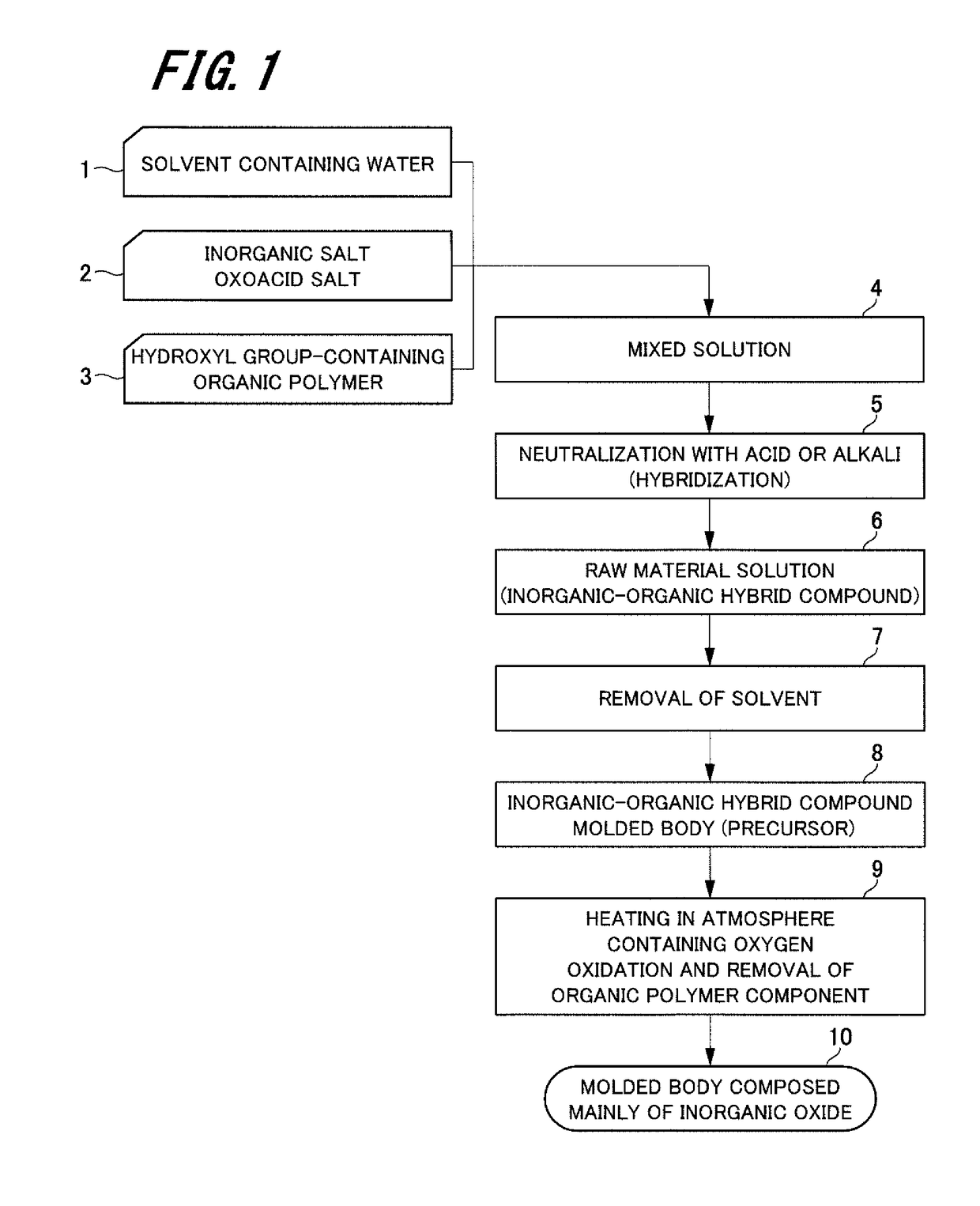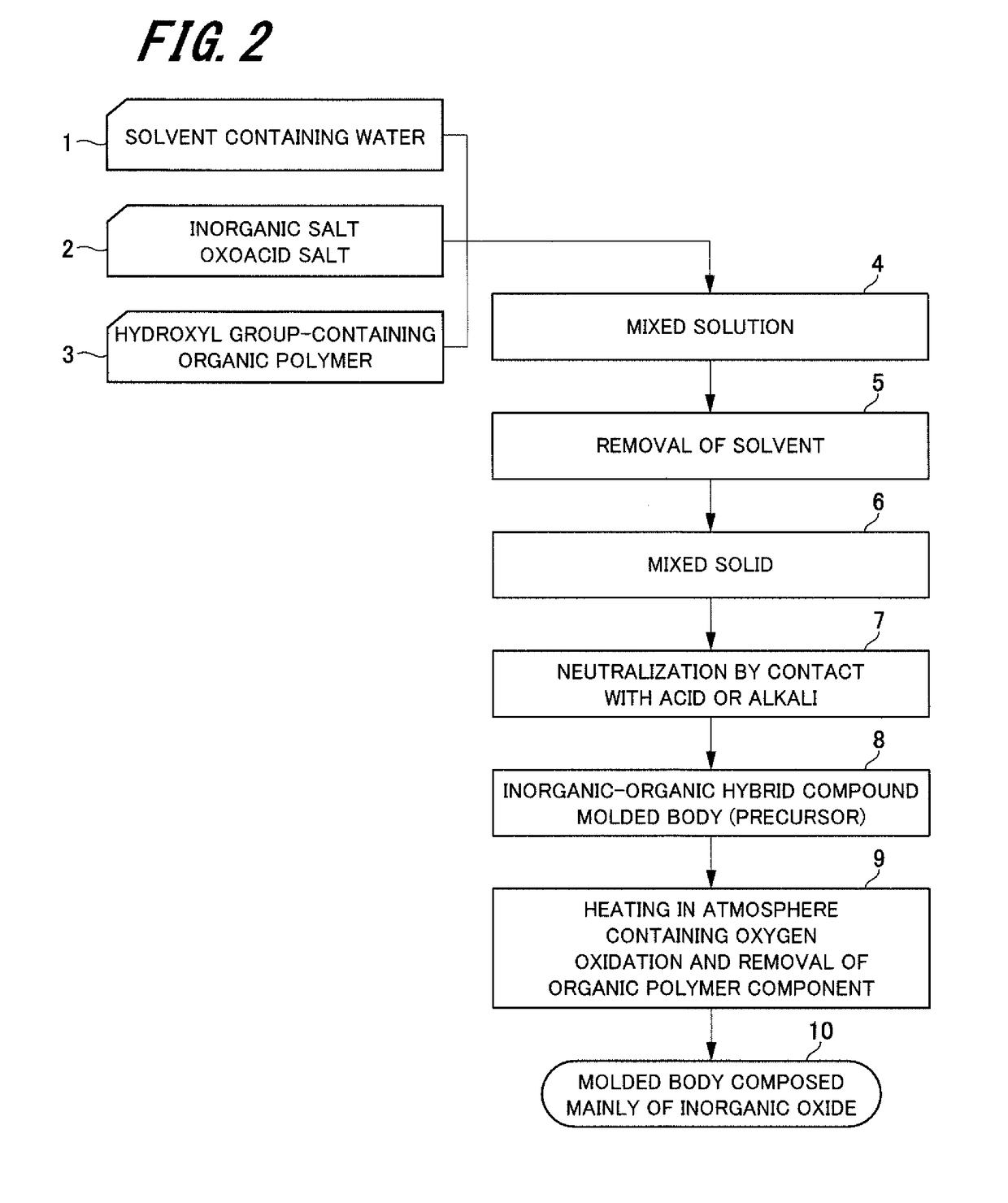Method of producing inorganic oxide molded body
a technology of inorganic oxide and molded body, which is applied in the direction of manufacturing tools, silicon compounds, cell components, etc., can solve the problems of not very high raw material cost and practicably difficult molding of inorganic oxide through melting process, and achieve high gas barrier properties, high melting point, and high strength.
- Summary
- Abstract
- Description
- Claims
- Application Information
AI Technical Summary
Benefits of technology
Problems solved by technology
Method used
Image
Examples
example 1
[0054]A method of producing an inorganic oxide molded body according to the present invention will be shown, in which a zirconium oxide molded body is taken as an example. The method in this example can also be applied to inorganic oxides other than zirconium oxide. This method is carried out in accordance with the production flow shown in FIG. 1. A solution obtained by dissolving 1.2 g of zirconium oxychloride octahydrate in 30 ml of water and a solution obtained by dissolving 0.5 g of trisodium phosphate in 22 ml of water were added to 16.7 g of a 12 wt % aqueous solution of polyvinyl alcohol (degree of polymerization: 3,100 to 3,900, degree of saponification: 86% to 90%), followed by mixing. While stirring the mixed solution, a NaOH aqueous solution with a concentration of 1 N was added thereto until the pH reached 6, and zirconium oxychloride was neutralized to obtain a raw material solution. By this operation, zirconium oxychloride was converted into a zirconic acid compound an...
example 2
[0061]The same operation as that of Example 1 was performed except that 5 g of a 4.5 wt % aqueous solution of sodium silicate was used instead of the zirconium oxychloride octahydrate of Example 1, and neutralization was performed by using a hydrochloric acid aqueous solution with a concentration of 2.4 N. In this case, a membrane-shaped precursor composed of a silicate compound-polyvinyl alcohol hybrid compound was formed. By heating the precursor in air, a film-shaped molded body of silica was produced. As in zirconium oxide in Example, a glassy molded body of silica originally having a melting point of 1,000° C. or higher was obtained at a temperature of 500° C. or lower.
example 3
[0062]A method of producing an inorganic oxide molded body in accordance with the production flow shown in FIG. 2 according to the present invention will be shown, in which a zirconium oxide molded body is taken as an example. The method in this example can also be applied to inorganic oxides other than zirconium oxide. A solution obtained by dissolving 1.2 g of zirconium oxychloride octahydrate in 30 cc of water was added to 16.7 g of a 12 wt % aqueous solution of polyvinyl alcohol (degree of polymerization: 3,100 to 3,900, degree of saponification: 86% to 90%), followed by mixing. The mixed solution was applied onto a glass substrate by using a spin coater under the conditions of 2,000 rpm and 60 seconds, and drying was performed by heating at 80° C. Where necessary, the operation of applying the raw material solution by using the spin coater, followed by heating was further repeated a plurality of times. After drying, immersion in a NaOH aqueous solution with a concentration of 1...
PUM
| Property | Measurement | Unit |
|---|---|---|
| temperature | aaaaa | aaaaa |
| melting point | aaaaa | aaaaa |
| temperature | aaaaa | aaaaa |
Abstract
Description
Claims
Application Information
 Login to View More
Login to View More - R&D
- Intellectual Property
- Life Sciences
- Materials
- Tech Scout
- Unparalleled Data Quality
- Higher Quality Content
- 60% Fewer Hallucinations
Browse by: Latest US Patents, China's latest patents, Technical Efficacy Thesaurus, Application Domain, Technology Topic, Popular Technical Reports.
© 2025 PatSnap. All rights reserved.Legal|Privacy policy|Modern Slavery Act Transparency Statement|Sitemap|About US| Contact US: help@patsnap.com



